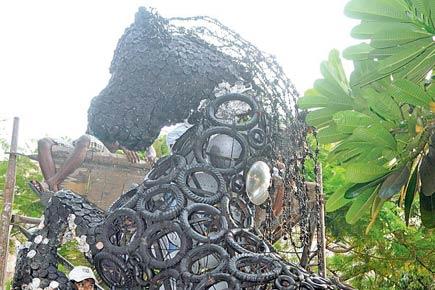The Kala Ghoda Festival will usher in February, the season of gigantic art installations, serpentine heritage walks and open-air performances, giving the city it’s annual dose of culture

An artist giving final touches to a 2012 art installation at the festival. Pic/Bipin Kokate
Kanika Sharma speaks to the team to understand how the elegant horse only seems to gallop faster, with every passing year
It’s crescent in shape and hums the legacy of a black equestrian. The legendary Kala Ghoda art district -- once, unbelievable as it sounds -- used to have MF Husain artworks displayed on the pavements; thanks to the annual fiesta that paints the neighbourhood in a prism of colours.
ADVERTISEMENT

An artist giving final touches to a 2012 art installation at the festival. Pic/Bipin Kokate
Yet, deciding to veer towards sepia tones, Kayomi Engineer, administrative director of the festival, draws us into its relevance, “Kala Ghoda Festival (KGAF) has become a mandate for the city. It is like a model for other festivals that have happened since -- be it, festivals in Powai, Virar, Worli or the second-most known after KGAF, Bandra.”

A 2011 installation captures the different moods at the venue. Pic/Sameer Markande
Inspired by the art district that currently has ushered in two new art hubs -- Delhi Art Gallery and House of Tales towards the end of 2013 -- the festival’s prime focus has always been heritage and culture conservation. Brinda Miller, festival director and an integral part of the event for the last 13 years, exclaims, “The interesting bit about all of us who are involved in the festival is that none of us have anything do to with the neighbourhood. Neither do we have our residences nor offices here; it’s the sheer love for the area that got us together to celebrate the festival.”

Singer Shaan performing with kids at the Kala Ghoda Festival in 2009
Start at the beginning
Shirin Bharucha, Saryu Doshi and Jamshed Kanga formed the Kala Ghoda Association in 1999 and also, birthed its more visible facet, the festival. Miller clarifies, “People mostly see the festival in February. But it’s during the rest of the year when we are working towards restoring the area. We are currently working on the gardens in the David Sassoon Library while we have contributed towards The Chhatrapati Shivaji Maharaj Vastu Sangrahalaya (CSMVS), Cama Hall, Elphinstone College and severalothers.”

Brinda Miller. File Pic
Combining the two together, the Sir JJ School of Art graduate has managed to do what she does best -- bring art to the public. “Our heritage walks are oversubscribed. Also, the platform has been known to launch the career of a number of artists such as Jayram Gopale and even singers like Shilpa Rao and Kavita Seth (who sung Iktara from Wake Up Sid).”
A unique feature the nine-day fest has is panning out to all kinds of disciplines. “Kala Ghoda is the largest multicultural festival of the country, if not in South Asia,” asserts Maneck Davar, a festival committee member. Being integrated as a national festival by the Maharashtra Tourism Development Corporation (MTDC) and dotting most itineraries of travellers to the city, the committee basks in pride.
All in one
“Our focus is to include everything that is good. 15 years earlier, we had to beg people to perform; now, we are in the position to curate. Also, when the festival started it was elitist in its orientation but presently, all classes are equally welcome,” shares Miller.
The fact that the number of programmes has grown from just 10-12 to 455, and the four beginning disciplines (music, dance, visual arts and theatre) grown to 12 -- is indicative of a moment of pride for Mumbaiites. We look forward to the 16th edition of aghostly King Edward VII trotting down amidst paraphernalia, weimagine what towering installations will astound the historicalpatron of arts.
From: February 1 to 9
What’s new?
» The newest section off the charts is Move Mumbai or the Urban Design and Architecture. “It will be about all the issues, be it good or bad, a Mumbaiite faces. Take the New Metro as an example,” Miller informs.
» The section will also canvas an exhibition that will display works of architects -- both established and the upcoming who will share how the city can be planned better.
» Speakers PK Das and Ratan Batliboi, will be part of the seminars that will be held under the section.
Walk down memory lane
» “For me, the concert at the Asiatic Library steps was the best that ever happened. The fact that Shankar-Ehsaan-Loy, Sunidhi Chauhan and Shaan performed at the concert at a minimal fee, drew huge crowds. They have been the three biggest acts that happened at the festival, till date.”
» “Last year, Usha Uthup gave us a cheque of '5,000 which had a story behind it. Long time back, when Usha Uthup had performed at the festival and she wasn’t that huge, a person had promised her that he will give her the sum for her charity. So, when she performed last year, the person met her and gave her the cheque. As a gesture, she presented the cheque to us representing what the festival means to her and how it was important when she was not very well-known.”
-- Brinda Miller
 Subscribe today by clicking the link and stay updated with the latest news!" Click here!
Subscribe today by clicking the link and stay updated with the latest news!" Click here!







